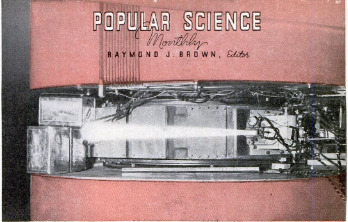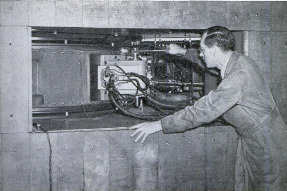-
Title (Dublin Core)
-
Giant atom gun
-
Article Title and/or Image Caption (Dublin Core)
-
Giant atom gun
-
extracted text (Extract Text)
-
STREAMING fanwise
from between the
poles of the world’s
largest magnet,
dazzling blue rays,
packed with more energy
than all the radium ever
mined, soon may pour
out of a colossal electric
“machine gun" 0 pow-
erful that it must be lo-
cated in an isolated spot
and operated by remote
control.
Completely surrounded
by tanks of water and
buried in a hillside to
guard against stray radi-
ations, the giant “cyclo-
tron” would be almost as
large as an ordinary
five-room house. Its
weird blue radiations
would be focused upon a
target placed in a vac-
uum chamber, and its
tremendous energy used
to produce amazing,
miraculous changes in ordinary substances like table salt and lead.
Only its cost of $750,000—the price of three bombing planes—is
delaying its construction. By the time these words are in print, the
huge generator may be taking shape at the University of California.
Plans were being drawn even as its proponent received word, late
last November, that he had been awarded the Nobel prize for devel-
opment of the decade's most revolutionary instrument in atomic
research.
‘Ten years ago the cyclotron was but a fantastic scheme in the
mind of a young professor at the University of California. Like
others, Dr. E. O. Lawrence had toyed with the idea of smashing the
atom by hurling a stream of minute bullets at it. He knew that ra-
dium, in its strange, centuries-long process of disintegration, hurls
out positively charged particles with peculiar powers. Under their
bombardment, atoms broke down and substances underwent re-
‘markable transformations. Now, if he could speed up the process by
generating billions of such particles, shooting them at terrific speed,
the alchemist’s dream of transmuting base metals into gold might
be realized.
Some experimenters had tried it already, firing smaller-than-atom
particles by huge electric discharges of 5,000,000 £0 10,000,000 volts.
But these electric machine guns could not be controlled—they flared
thunderously for an instant, leaving behind a tangle of wrecked, smoking equipment and
shattered insulators.
Dr. Lawrence's scheme
was fantastic, yet simple.
Whirl the particles as if in
an old-fashioned slingshot,
round and round, adding
force at each revolution;
then let go, sending the
shot whizzing out with the cumulative ener-
gy of all the revolutions. For the sling he
would use a large magnetic field; for wrist
power he would substitute a high-power
radio-frequency _ oscillator. Securing an
eighty-five-ton electromagnet originally de-
signed for an arc radio transmitter for the
Chinese Government, he demonstrated the
soundness of his scheme so sensationally
that it led at once to the building of a 200-
ton instrument which even now, in the hands
of the laboratory's research staff of twenty
physicists, is making history at the Univer-
sity of California. It will fire bullets with an
energy far greater than most lightning
flashes, projecting bits of matter at a ve-
locity of 25,000 miles a second—fast enough
to travel to the sun in an hour.
This amazing speed is made possible by
a method of electrical timing resembling an
automobile ignition system. At the heart of
the cyclotron is a closed vacuum chamber
shaped like a huge copper frying pan, near-
ly filled with two big, flat, D-shaped elec-
trodes. Down the center runs a tungsten
filament. Fat hydrogen atoms obtained by
electrically decomposing “heavy” water (im-
ported from Norway at ninety-five cents a.
gram) are squirted into the pan. Sizzling
against the hot filament, they are “ionized”
into fragments which instantly are seized
by the electric and magnetic field and sent
spinning on a circular path. Just then a
powerful short-wave transmitter delivers a
400,000-volt. ick across the D's, giving a
tremendous boost to the racing particles.
Halfway around the circle, another shock,
nicely timed, adds again to their speed.
Forty times around, the energy multiplied
eighty times, and out they fly through a
window of paper-thin aluminum. Substances
to be bombarded are put into a small vacuum
chamber which is bolted onto the very muz-
ule of the big gun.
BUT this machine, now the world's largest,
‘will seem a mere pygmy beside the giant
Dr. Lawrence hopes to build. When this is
done and the experimenters use their 5,000-
ton machine gun to fire at atoms as a farmer
uses a shotgun to pepper away at crows,
two kinds of hits are possible. If they hit a
platinum atom squarely, for instance, they
may turn it into gold by loading it full of
“glug,” thus raising its atomic weight. But
if they shoot away part of an atom, still an-
other new substance results. Shattering an
atom of lithium, lightest of metals, converts
it into the gas, helium. Most bullets miss,
but the success of the gun lies in the fact
that they are poured out at the rate of 5,000,
000 billions a second, Yet they are so small
that several million millions of them could
be fired into the point of a pin, without hit-
ting the same spot twice!
Cyclotron experts don’t expect to revolu-
tionize industry by making precious metals
in the laboratory on a commercial scale.
‘When they turn a common metal into gold,
for instance, they do not get pure gold, but
a mixture of the two. Chemical tests show
the gold to be just as real as gold from the
mine—but to keep on shooting until all the
atoms were hit and the whole piece turned
to gold, would take many years and so much
power that you could mine the gold much
more cheaply. Besides, why waste this
energy making a metal worth only thirty-
five dollars an ounce, when you can produce
the equivalent of the rarest of metals, worth
hundreds of times as much?
Physicists say a gram of radium—a piece
about three times the size of a pinhead—
shoots out thirty billion particles a second;
but the big cyclotron will emit 5,000,000 bil-
lions! Radium’s bullets go out in all direc-
tions and are largely wasted; but the cyclo-
tron concentrates all its tremendous energy
into a slot about the size of a man's thumb,
and its energy corresponds, not to a gram,
but a ton of radium—many times the amount
that has been mined in nearly half a cen-
tury since its marvelous powers were discov-
ered.
Still more sensational is its amazing abil-
ity to create new (Continued on page 225)
forms of matter. Everyone of the known
chemical elements has been changed into
from one to as many as eight new forms.
Well-known substances like iron and oxy-
gen may be produced in several totally dif-
ferent kinds. Already more than 300 sub-
stances never before known on earth have
been created, and experimenters are busy
investigating their unknown properties.
Most of these materials are radioactive—
they lose no time in trying to get rid of the
foreign particles that have been fired into
them, and, in expelling them, duplicate the
action of radium itself. Radio-iron, radio-
phosphorus, radio-iodine—these are but a
few of the unheard-of new products already
being studied for their chemical and their
medicinal applications. Some have a pecu-
liar way of going straight to a certain part
of the body—radio-phosphorus to the bones,
radio-iodine to the thyroid gland—and so
fire their tiny bullets at point-blank range,
thus promising vast improvement in the
treatment of certain diseases.
Power from the atom still remains an un-
realized dream, but the making of unstable,
radioactive substances is a first step in that
direction. A gram of natural radium will
boil its own weight in water every hour—
and, at the end of 1,500 years, still will have
half its original energy lett. Imagine the
power available if similar reactions could
be started, then converted into chain reac-
tions, each exploding the next, like a string
of firecrackers!
Except in rare instances, atomic bullets
fired from the present cyclotron only knock
what might be called chips from the bom-
barded atoms, With bullets of 100,000,000
volts energy, atoms may be broken into
many fragments. Such energies could be
obtained with a giant cyclotron.
Strangely, water and paraffin are among
the best insulators against the ray, and a
forty-inch lead tank filled with paraffin
acts as “backstop” behind the vacuum tar-
get chamber. A portable indicator carried
about the laboratory in a small box meas-
ures the amount of the rays bouncing off
solid objects. As a precaution against un-
noticed reflections, every research man in
the laboratory has periodic blood tests, to
be sure he isn't getting an overdose of the
rays. Lead-lined rubber gloves and tongs
are used to handle the “artificial radium”
after bombardment, and staff men are care-
ful not to pick up barehanded any part of
the target chamber or even the tools used
in handling it.
-
Contributor (Dublin Core)
-
Sterling Gleason (article writer)
-
Language (Dublin Core)
-
eng
-
Date Issued (Dublin Core)
-
1940-05
-
pages (Bibliographic Ontology)
-
47-51
-
Rights (Dublin Core)
-
Public domain
-
Archived by (Dublin Core)
-
Sami Akbiyik
-
Marco Bortolami (editor)
 Popular Science Monthly, v.136, n. 5, 1940
Popular Science Monthly, v.136, n. 5, 1940
 Ekran Resmi 2022-01-13 12.55.03.png
Ekran Resmi 2022-01-13 12.55.03.png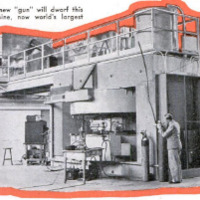 Ekran Resmi 2022-01-13 12.55.13.png
Ekran Resmi 2022-01-13 12.55.13.png Ekran Resmi 2022-01-13 12.55.20.png
Ekran Resmi 2022-01-13 12.55.20.png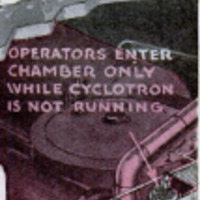 Ekran Resmi 2022-01-13 12.55.31.png
Ekran Resmi 2022-01-13 12.55.31.png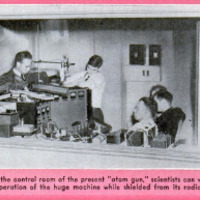 Ekran Resmi 2022-01-13 12.55.41.png
Ekran Resmi 2022-01-13 12.55.41.png Ekran Resmi 2022-01-13 12.55.49.png
Ekran Resmi 2022-01-13 12.55.49.png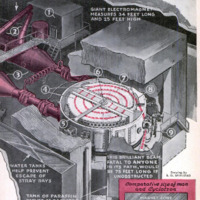 Ekran Resmi 2022-01-13 12.55.58.png
Ekran Resmi 2022-01-13 12.55.58.png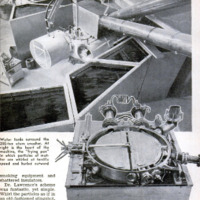 Ekran Resmi 2022-01-13 12.56.06.png
Ekran Resmi 2022-01-13 12.56.06.png Ekran Resmi 2022-01-13 12.56.15.png
Ekran Resmi 2022-01-13 12.56.15.png
